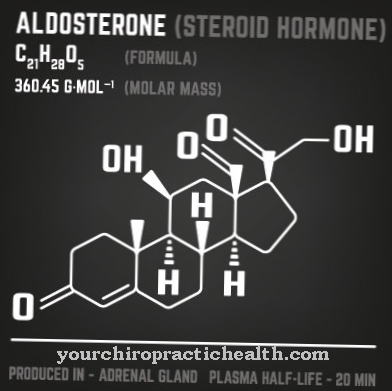At a Distal humeral fracture it is a bone fracture that is located in the area of the lower end of the upper arm bone (medical name humerus). In children, such fractures are mainly caused by falls with an outstretched arm, while in adults, falls on the elbow joint are often responsible for distal humerus fractures.
What is a distal humeral fracture?

© logo3in1 - stock.adobe.com
In the context of a distal humeral fracture, fractures occur in the humerus, with adults and children being affected by the fractures at different rates. In adults, the distal humerus fractures make up about three percent of all fractures of the extremities, while in children it is up to ten percent. Thus, the distal humerus fracture is a rarely occurring form of bone fracture.
Distal humerus fractures are difficult to treat fractures. They occur more frequently in children between the ages of five and ten years, accounting for about five percent of all fractures, but 80 percent of all child fractures of the elbow.
causes
The possible causes for the development of a distal humeral fracture can vary. As with fractures that are outside the joint and partial joint fractures are common, the main causes are direct or indirect force applied to the affected bone. Fractures outside the joint (medical term extra-articular fractures) are divided into various categories depending on the mechanism of the accident.
These include the more common extension fractures and flexion fractures, which are far less common. Most of these occur in children. If the distal humeral fracture is a complete fracture of the joint, the cause is the direct application of force.
Symptoms, ailments & signs
A distal humerus fracture can cause various symptoms and complaints for the affected patient. First and foremost, the people suffer from severe pain. The pain starts from the area of the fracture, but radiates and can reach far beyond the upper arm.
Under these circumstances, movements of the arm affected by the distal humerus fracture are hardly possible. In addition to the pain, swelling, deformities and palpable and audible crepitation also occur as a rule. This is understood as the rubbing of fracture parts together, which in most cases is associated with severe pain.
In addition, the distal humerus fracture can be associated with other complaints, for example if it was caused by a fall and other injuries, for example in the form of abrasions or larger open wounds, have formed. Other symptoms that can arise in connection with a distal humerus fracture are, for example, damage to the brachial artery from the extension fractures.
In addition, a so-called Volkmann contracture can develop on the flexor side due to a lesion of vessels and nerves. Damage to the ulnar nerve and the radial nerve can also be side effects that can occur with a distal humerus fracture. However, these are rarely observed.
diagnosis
Various examination methods are available for diagnosing a distal humeral fracture. In most cases, an examination using x-rays is used. The attending physician carries out this examination in two planes in order to be able to analyze the distal humerus fracture from different sides. This diagnostic method is usually sufficient to make a reliable diagnosis and to plan a possible operation.
For further clinical concerns it is sufficient to differentiate between a few fracture forms. As a rule, a distinction is made between three forms, namely (metaphyseal) fractures affecting the bone, fractures located in the joint capsule (intra-articular) or outside the joint (extra-articular). This classification has proven itself over the long term and is used by most doctors.
During the clinical examination, the blood circulation, sensitivity and motor functions of the affected arm as well as the hands and fingers should be checked. Corresponding diagnoses related to the distal humerus fracture are confirmed by means of X-rays.
Complications
The distal humerus fracture is a rarely occurring complicated bone fracture at the lower end of the humerus. These limb fractures mainly occur when falling with an outstretched arm or on the elbow joint. The symptom is more likely to occur in children than adults.
Affected people suffer from severe pain that extends well over the shoulder. The arm can hardly be moved and is misaligned. When palpating, crackling noises can be heard from the fracture parts. Swelling and bruises also appear, especially if the upper arm artery has been injured.
If the symptom is not treated as soon as possible, the complications will increase. Concomitant symptoms such as severe abrasions or open wounds can become infected. Nerves and blood vessels in the flexor side of the arm can be permanently damaged. The consequences are circulatory and sensitivity disorders, but also permanent motor damage that extends into the fingers.
The distal humerus fracture includes various types of fracture that can affect one or more bones and the joint capsule. Imaging measures clarify the type of break for the operative measure. The operation of the distal humerus fracture is often complicated. The soft tissue jacket must be able to form a new stable connection to the bone structure and a precisely fitting joint surface reconstruction must be carried out. Then the patient has to undergo physiotherapy.
When should you go to the doctor?
If a distal humerus fracture is suspected, a doctor should be consulted immediately, who can clarify the symptoms and, if necessary, treat them directly. If you experience severe pain in your upper arm after a fall or accident, it is best to call an emergency doctor directly.
Swelling, misalignment or bleeding also indicate a medical emergency that must be clarified immediately. At the latest when symptoms of a shock are noticed, the emergency number must be dialed immediately. Open abrasions can sometimes be self-treated.
However, due to the risk of infection alone, this task should be left to the doctor. If nerves or vessels have been injured, this must be treated in hospital in any case. Otherwise, the symptoms will increase and permanent motor damage can occur, which can extend from the shoulder to the fingers.
In the case of nerve damage, further physiotherapeutic treatment may be necessary. The doctor responsible should best answer which specific measures have to be taken to restore the mobility and performance of the upper arm.
Doctors & therapists in your area
Treatment & Therapy
Various methods are available for the treatment of a distal humerus fracture. These are used depending on the type of fracture and the severity of the fracture.
In the majority of cases, the distal humerus fracture is treated surgically by applying a plate fixation or alternatively a screw fixation. If the fractures are particularly complex and no longer allow reconstruction, treatment with an elbow joint prosthesis must be considered in individual cases.
The possibility of conservative treatment is far less common in the presence of a distal humeral fracture. For this, the fracture fragments must not be displaced from their original position and there must be no instability. In conservative therapy, an upper arm cast is applied for a period of three to six weeks. If children have a distal humeral fracture, the prognosis is usually good.
Outlook & forecast
The distal humerus fracture heals well in most cases. Children have the best prognostic prospects and can often be symptom-free for life after healing. The older the patient, the worse the fracture heals. Overall, the healing process is longer and there are often restrictions on the range of motion.
In children, complications and consequential damage can occur if the growth plate in the distal humerus fracture is affected. This leads to problems with reduction and can negatively affect the very favorable prognosis.
Adults suffer more and more from permanent restrictions of movement, since the bones no longer grow together in their natural form with increasing age. In addition to the mobility restrictions, a loss of the usual level of performance or sensitivity to the weather can be expected. Nevertheless, the patient achieves a good quality of life with the distal humerus fracture and does not have to expect paralysis or similar restrictions.
Often there are bad postures or necessary changes to the usual movement sequences. These are necessary to avoid or reduce muscle, tendon or nerve damage. Through targeted training and exercises, the patient can learn to stress his body differently. This improves general wellbeing and alleviates existing complaints. This process takes several months until the patient is almost symptom-free.
prevention
As with most fractures, the best way to prevent a distal humerus fracture is through increased attention to potentially dangerous activities. Corresponding joint protectors should be worn, especially in sports where more falls can occur. With sufficient force, however, even these cannot guarantee protection against a distal humerus fracture.
Aftercare
In most cases, the patient has very few measures or options for follow-up care available to the patient, so that early detection must primarily be carried out in order to prevent further complications or restrictions in movement. The earlier the humeral fracture is diagnosed and treated, the better the further course of this disease is usually.
Self-healing cannot occur, so a visit to a doctor is necessary. In most cases, the humerus fracture is treated with the help of surgical interventions that are intended to permanently alleviate the symptoms. It is advisable for those affected to rest after such an operation and take it easy for a while. Refrain from exertion or other stressful activities.
Above all, the affected area on the body should not be unnecessarily stressed. Furthermore, physiotherapy measures are usually very useful. As a rule, the affected person can also perform many exercises from such a therapy in their own home and thus possibly accelerate the healing process. In most cases, the humeral fracture does not reduce the life expectancy of the person affected.
You can do that yourself
If there is a distal humerus fracture, the arm in question is immobilized for several weeks. This is usually done with plaster of paris. As a result, everyday life is severely restricted, as movements are only possible with the other arm.
The prescribed rest is very important, because otherwise the arm cannot heal undisturbed. For this reason, the position of the arm should always remain on the upper body - even at night. This is not always easy - but there is no alternative.
Once the fracture has healed and the cast is removed, it is crucial to reactivate the arm with the help of physiotherapeutic measures. This must be done gradually. Excessive demands in everyday life should be avoided at all costs.
In most cases, it takes several months for the arm to be fully resilient again. In the beginning, only light objects may be lifted and light work carried out.
Anyone who has previously done sport should wait as long as the doctor recommends. This can take four to six months. It is not uncommon for about a year to pass before the arm is fully functional again. If the weather changes, the former break point can still be noticeable for several years.



























